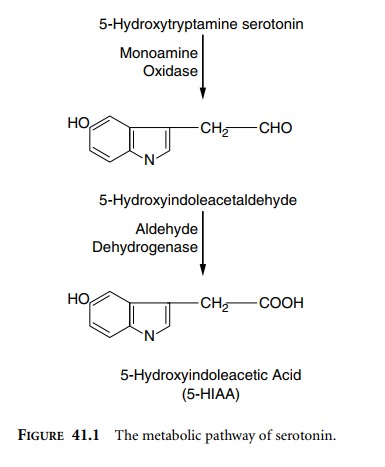Chapter: Clinical Cases in Anesthesia : Carcinoid Syndrome
What are carcinoid tumors?
What are
carcinoid tumors?
Carcinoid
is a slow-growing
tumor arising from enterochromaffin cells identified by
silver staining of cytoplasmic granules within the cells. These cells release
vasoactive substances, which have amine precursors. The substances include
serotonin, prostaglandin, histamine, and kallikreinins. Histologically,
carcinoid tumors that arise from the ileum demonstrate dense nests of cells
with uniform size and nuclear appearance. Histochemically, they typically
exhibit an argentaffin reaction in which the cells convert silver salts to a
metallic silver color. A positive argentaffin reaction is not required for
diagnosis. Tumors arising from the embryonic foregut usually contain few
argentaffin cells.
Bronchogenic carcinoid can range from having
typical carcinoid features to being indistinguishable from oat cell carcinoma
of the lung. Tumors arising from the ileum or jejunum produce more common
manifestations of carcinoid syndrome, such as cutaneous flushing, intestinal
hypermobility, and hypotension caused by serotonin release. Tumors arising from
the stomach usually tend to produce histamine, causing hypotension and less
commonly wheezing. Carcinoid syndrome was originally thought to be due to
serotonin and histamine only. These agents predominate in the syndrome;
however, more recently other hormone and vasoactive polypep-tides have been
identified. The mediators include prostaglandins, bradykinins, tachykinins,
adrenocorti-cotropic hormones, and vasoactive intestinal peptide (VIP).
Serotonin is produced from tryptophan by a hydroxylation and decarboxylation
reaction. It is broken down ultimately to 5-HIAA by the enzymes monoamine
oxidase and alcohol dehydrogenase (Figure 41.1). The measurement of 5-HIAA in
the urine is used to monitor the disease process clinically.


Histamine release is seen more commonly with
foregut carcinoid tumors and is thought to cause bronchospasm associated with
flushing. Serotonin causes vasodilation and vasoconstriction; therefore, both
hypotension and hyperten-sion can be seen. Serotonin has no effect on cardiac
function itself at normal levels; however, at elevated levels it can cause
positive chronotropic and inotropic responses. Other effects due to high
serotonin levels are increased gut motility, and secretion of sodium chloride
(NaCl), potassium (K+), and water by the small intestine.
Hyperglycemia can also occur from elevated adrenergic levels as well. Patients
may exhibit prolonged effects from anesthesia with excessive postopera-tive
drowsiness. Bradykinins can cause severe hypotension secondary to extreme
vasomotor relaxation or vasodilation. Flushing can occur due to enhanced nitric
oxide synthesis. Bronchospasm can follow, especially in patients with cardiac
disease or asthmatics.
Related Topics